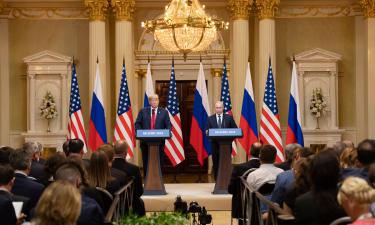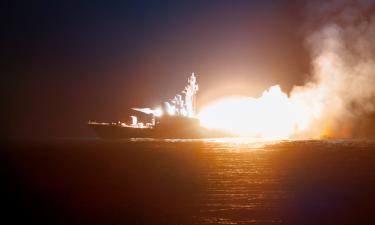Astronaut to play golf in space
Russian cosmonaut Mikhail Tyurin was late for his tee time in space, but still managed to launch a super-lightweight golf ball into orbit even if he shanked his shot.

Tyurin hit the golf ball 77 minutes behind schedule Wednesday after delays to fix an overheating spacesuit and a stuck exterior hatch.
Using a gold-plated six-iron and an American astronaut in the role of caddy-and-safety-holder, Tyurin hit the drive from a spring-like tee outside the international space station, 220 miles (355 kilometers) over the northwest Pacific Ocean. The shot, which veered a little to the right, kicked off a problem-plagued slightly shortened spacewalk.
"I can see it as a little dot moving away from us," Tyurin said.
But just how far did that baby go?
Like in any golf story, it depends on who you talk to.
That drive went 1 billion miles (1.6 billion kilometers) or will by the time it eventually comes down in a couple years said Nataliya Hearn, the president of Element 21 Golf Company. The Toronto firm is paying the cash-starved Russian space agency an undisclosed amount for the golf stunt to promote its new golf club that includes a space-program-derived metal.
That's a huge exaggeration, according to NASA's lead spacewalk flight director, Holly Ridings. She said NASA's calculations are that golf balls would only stay up two to three days, which would put the drive closer to a mere million miles (1.6 million kilometers).
Just how far the golf ball travels won't be known until the ball burns up and enters Earth's atmosphere. The ball weighs 3 grams, only about 1/15th the weight of a normal golf ball. It weighs less to minimize any damage should it actually strike something.
Like many golfers, Tyurin spent several minutes trying to get comfortable addressing the ball, but unlike his Earth-bound counterparts, at times he was upside down. He was tethered to the space station and had astronaut Michael Lopez-Alegria holding on to him.
With Moscow Mission Control deliberating on how to position the ball on the tee, Tyurin, a veteran spacewalker but rookie golfer who was already more than an hour late, was cranky about the advice.
"The ball is the least of our concerns," Tyurin said. "It's me that is supposed to be positioned properly."
NASA spacewalk commentator Rob Navias, who was not broadcasting in golf's traditional hushed tones, noted that Tyurin's shot sliced to the right. An agitated Tyurin opted not to take a planned second or third shot.
For a few tense minutes it looked like Tyurin might miss his tee time and spacewalk entirely when his space suit overheated and the bulky hatch door got stuck.
Tyurin told flight controllers in Moscow that his spacesuit was too hot probably because of an excessively kinked cooling hose. Eventually, the suit started cooling, Tyurin got back in, and the tee time was a go, however flight controllers decided to cut the spacewalk short from a planned six hours to five hours and 38 minutes. Later in the spacewalk, water accumulated in Tyurin's spacewalk and fogged up his visor, reports AP.
After Tyurin's golf shot, Tyurin and Lopez-Alegria installed a science experiment and relocated one antenna on the space station.
However, the spacewalkers failed to dislodge a different stuck antenna on a docked unmanned supply ship, despite several tries punctuated by grunts and mutterings. Russian engineers think there may be something frozen in the antenna's drive mechanism. And they had trouble closing the same balky hatch when it was time to end the spacewalk.
Tyurin's shot was not the first in space. Astronaut Alan Shepard took a swing on the moon during the Apollo 14 mission in 1971.
Subscribe to Pravda.Ru Telegram channel, Facebook, RSS!




